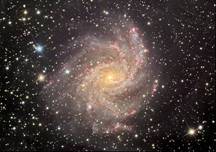 This has been a busy month for extrasolar planet discoveries. First amateur astronomers discovered a planet orbiting four stars. That's right, if you lived there you'd have up to four suns in the sky (of course when you visit, some of them may have set ;). This planet is about the size and composition of gaseous Neptune - so you couldn't actually stand on the planet. But imagine the view!
This has been a busy month for extrasolar planet discoveries. First amateur astronomers discovered a planet orbiting four stars. That's right, if you lived there you'd have up to four suns in the sky (of course when you visit, some of them may have set ;). This planet is about the size and composition of gaseous Neptune - so you couldn't actually stand on the planet. But imagine the view!
Second, the planet around Alpha Centauri is doubly cool - first because Alpha Centauri the closest star system to us - and second because it is really a triple star system, two big stars orbiting each other with a tiny third one nearby. Alpha Centauri A is a star just slightly larger than the Sun and Alpha Centauri B is a smidgen smaller than ole Sol. The third star is Proxima Centauri which happens to be slightly closer to Earth than the others. So finding a planet around a triple star system was unheard of just a few months ago. This planet orbits around Alpha Centauri B every 3.2 days only 3.6 million miles from the star. It's though that the surface is rocky but boiling at an average temperature 2,240 degrees F! Hopefully, this is just the first of many discoveries we make in our stellar neighborhood.
 |
| Artist rendition of planet Alpha Centauri Bb |
Now before you start packing your bags for Alpha Centauri Bb, remember that it is still over 25 trillion miles away. The New Horizons space craft would take over 74,000 years to get there!
-













